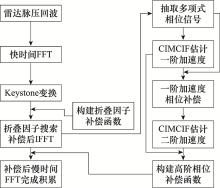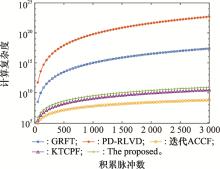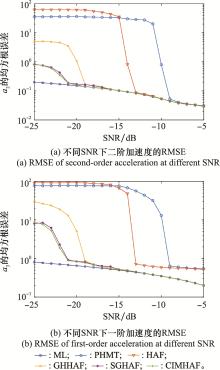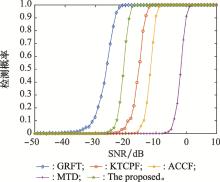Systems Engineering and Electronics ›› 2022, Vol. 44 ›› Issue (12): 3811-3820.doi: 10.12305/j.issn.1001-506X.2022.12.26
• Guidance, Navigation and Control • Previous Articles Next Articles
Research on long-time coherent integration and parameter estimation algorithm of high-speed maneuvering targets
Yuchao YANG*, Ming FANG, Chenfan ZHAO, Yueqi WANG, Gang FANG
- Shanghai Aerospace Electronic Technology Institute, Shanghai 201109, China
-
Received:2021-09-06Online:2022-11-14Published:2022-11-24 -
Contact:Yuchao YANG
CLC Number:
Cite this article
Yuchao YANG, Ming FANG, Chenfan ZHAO, Yueqi WANG, Gang FANG. Research on long-time coherent integration and parameter estimation algorithm of high-speed maneuvering targets[J]. Systems Engineering and Electronics, 2022, 44(12): 3811-3820.
share this article
| 1 | 曾涛, 温育涵, 王岩, 等. 合成孔径雷达参数化成像技术进展[J]. 雷达学报, 2021, 10 (3): 327- 341. |
| ZENG T , WEN Y H , WANG Y , et al. Research progress on synthetic aperture radar parametric imaging methods[J]. Journal of Radars, 2021, 10 (3): 327- 341. | |
| 2 |
宋之玉. 陆军战术雷达对抗技术研究[J]. 航天电子对抗, 2020, 36 (1): 39- 45.
doi: 10.3969/j.issn.1673-2421.2020.01.009 |
|
SONG Z Y . Countermeasures technology of army tactics-radar[J]. Aerospace Electronic Warfare, 2020, 36 (1): 39- 45.
doi: 10.3969/j.issn.1673-2421.2020.01.009 |
|
| 3 |
JAYA E , KRISHNA B T . A particle fuzzy decisive framework for moving target detection in the multichannel SAR framework[J]. International Journal of Computational Intelligence and Applications, 2020, 19 (4): 2050032.
doi: 10.1142/S1469026820500327 |
| 4 |
SONG Y K , JIN T , SONG Y P , et al. An improved Radon-Fourier transform coherent integration method[J]. IEEE Access, 2019, 7, 138593- 138602.
doi: 10.1109/ACCESS.2019.2942168 |
| 5 |
SUN Z , LI X L , CUI G L , et al. Hypersonic target detection and velocity estimation in coherent radar system based on scaled Radon Fourier transform[J]. IEEE Trans.on Vehicular Technology, 2020, 69 (6): 6525- 6540.
doi: 10.1109/TVT.2020.2988990 |
| 6 |
JIN K , LAI T , WANG Y B , et al. Radar coherent detection for Doppler-ambiguous maneuvering target based on product scaled periodic Lv's distribution[J]. Signal Processing, 2020, 174, 107617- 107629.
doi: 10.1016/j.sigpro.2020.107617 |
| 7 |
ZHAO L X , TAO H H , CHEN W J , et al. Maneuvering target detection based on subspace subaperture joint coherent integration[J]. Remote Sensing, 2021, 13 (10): 1948- 1966.
doi: 10.3390/rs13101948 |
| 8 |
LI X L , KONG L J , CUI G L , et al. A low complexity coherent integration method for maneuvering target detection[J]. Digital Signal Processing, 2016, 49, 137- 147.
doi: 10.1016/j.dsp.2015.10.008 |
| 9 | LI X L , CUI G L , YI W , et al. Manoeuvring target detection based on keystone transform and Lv's distribution[J]. IET Radar, Sonar & Navigation, 2016, 10 (7): 1234- 1242. |
| 10 |
ZHENG J B , LIU H W , LIU Z , et al. ISAR imaging of ship targets based on an integrated cubic phase bilinear autocorrelation function[J]. Sensors, 2017, 17 (3): 498- 511.
doi: 10.3390/s17030498 |
| 11 |
ZHENG J B , LIU H W , LIU Z , et al. Parameterized two dimensional representation for multicomponent cubic phase signals and its application in ISAR imaging of fluctuating ship[J]. Digital Signal Processing, 2018, 78, 218- 231.
doi: 10.1016/j.dsp.2017.09.009 |
| 12 | LI X L , KONG L J , CUI G L , et al. CLEAN-based coherent integration method for high-speed multi-targets detection[J]. IET Radar, Sonar & Navigation, 2017, 10 (9): 1671- 1682. |
| 13 | CHEN X L , GUAN J , LI X , et al. Effective coherent integration method for marine target with micromotion via phase differentiation and Radon-Lv's distribution[J]. IET Radar, Sonar & Navigation, 2015, 9 (9): 1284- 1295. |
| 14 |
XU J , XIA X G , PENG S B , et al. Radar maneuvering target motion estimation based on generalized Radon-Fourier transform[J]. IEEE Trans.on Signal Processing, 2012, 60 (12): 6190- 6201.
doi: 10.1109/TSP.2012.2217137 |
| 15 | LI X L, CUI G L, YI W, et al. A fast non-searching method for maneuvering target detection based on ACCF[C]//Proc. of the IEEE Radar Conference, 2015: 11-14. |
| 16 |
GOLDEN S , FRIEDLANDER B . Maximum likelihood estimation, analysis, and applications of exponential polynomial signals[J]. IEEE Trans.on Signal Processing, 1999, 47 (6): 1493- 1501.
doi: 10.1109/78.765111 |
| 17 |
HUANG P H , LIAO G S , XIA X G , et al. Ground maneuvering target imaging and high-order motion parameter estimation based on second-order keystone and generalized Hough-HAF transform[J]. IEEE Trans.on Geoscience and Remote Sensing, 2017, 55 (1): 320- 335.
doi: 10.1109/TGRS.2016.2606436 |
| 18 |
HUANG P H , XIA X G , LIAO G S , et al. Ground moving target refocusing in SAR imagery using scaled GHAF[J]. IEEE Trans.on Geoscience and Remote Sensing, 2018, 56 (2): 1030- 1045.
doi: 10.1109/TGRS.2017.2758262 |
| 19 |
WANG Y , JIANG Y C . ISAR imaging of a ship target using product high-order matched-phase transform[J]. IEEE Trans.on Geoscience and Remote Sensing Letters, 2009, 6 (4): 658- 661.
doi: 10.1109/LGRS.2009.2013876 |
| 20 |
ZHU L . Quadratic frequency modulation signals parameter estimation based on product high order ambiguity function-modified integrated cubic phase function[J]. Information, 2019, 10 (4): 140- 153.
doi: 10.3390/info10040140 |
| [1] | Yili HU, Yongbo ZHAO, Sheng CHEN, Ben NIU. Decoherence of conformal electromagnetic vector sensor array by double interpolation fitting method [J]. Systems Engineering and Electronics, 2022, 44(8): 2393-2402. |
| [2] | Yuanyi XIONG, Wenchong XIE. Adaptive iterative monopulse estimation method based on space-time constraint [J]. Systems Engineering and Electronics, 2022, 44(8): 2506-2514. |
| [3] | Yan JIN, Dadi ZHAO, Hongbing JI. Parameter estimation of LFM signals based on NAT functions in impulsive noise [J]. Systems Engineering and Electronics, 2022, 44(3): 762-770. |
| [4] | Zengmao CHEN, Li LU, Zhiguo SUN, Rongchen SUN. Parameter estimation algorithm of convolutional codes with solving cost function based on conjugate gradient [J]. Systems Engineering and Electronics, 2022, 44(10): 3235-3242. |
| [5] | Yiheng ZHOU, Jun YANG, Saiqiang XIA, Mingjiu LYU. Estimation method of micro-motion parameters for rotor targets under flashing [J]. Systems Engineering and Electronics, 2022, 44(1): 54-63. |
| [6] | Rongyan ZHOU, Jianfeng CHEN, Xiaoqiang LI, Weijie TAN. Optimal deployment method of sensors in localization system based on targets with Gaussian distribution [J]. Systems Engineering and Electronics, 2021, 43(7): 1791-1796. |
| [7] | Ling WANG, Hua PAN, Wei ZHAO. Low complexity 2D-DOA estimation algorithm in the presence of mutual coupling [J]. Systems Engineering and Electronics, 2021, 43(7): 1819-1823. |
| [8] | Manying WANG, Xiaofeng GONG, Ruisen LUO, Tong BIAN, Zhiyuan WANG. Joint blind parameter estimation of frequency hopping signal based on adaptive morphology [J]. Systems Engineering and Electronics, 2021, 43(5): 1398-1405. |
| [9] | Binbin LI, Hui CHEN, Weijian LIU, Zhaojian ZHANG, Bilei ZHOU. Joint multi-dimensional parameters estimation for large-sized electromagnetic vector sensor array based on sparse reconstruction in limited snapshots [J]. Systems Engineering and Electronics, 2021, 43(4): 868-874. |
| [10] | Jiahua XU, Xiaokuan ZHANG, Shuyu ZHENG, Binfeng ZONG, Shuchang ZHENG. GTD model parameter estimation and target recognition based on improved 3D-ESPRIT algorithm [J]. Systems Engineering and Electronics, 2021, 43(2): 336-342. |
| [11] | Weiting FENG, Qing LIANG, Jing GU. Micro-motion parameters extraction for rotating targets based on FMCW radar [J]. Systems Engineering and Electronics, 2021, 43(12): 3564-3570. |
| [12] | Jia LIU, Kewei YANG, Jiang JIANG, Boyuan XIA. Parameter estimation method of equipment system based on multi-fidelity surrogate model [J]. Systems Engineering and Electronics, 2021, 43(1): 130-137. |
| [13] | Shengkui ZHANG, Zhicheng YAO, Min HE, Zhiliang FAN, Jian YANG. FH signal parameter blind estimation based on time-frequency variance clustering [J]. Systems Engineering and Electronics, 2020, 42(8): 1662-1667. |
| [14] | Shuyu ZHENG, Xiaokuan ZHANG, Binfeng ZONG, Jiahua XU, Jiang LI. PQ-FB-2D-ESPRIT algorithm for parameter estimation of 2D-GTD model [J]. Systems Engineering and Electronics, 2020, 42(6): 1283-1289. |
| [15] | ZHANG Yongshun, ZHU Weigang, JIA Xin, WANG Manxi. NBI detection and parameter estimation in DSSS communications based on BSBL [J]. Systems Engineering and Electronics, 2019, 41(4): 889-897. |
| Viewed | ||||||
|
Full text |
|
|||||
|
Abstract |
|
|||||











